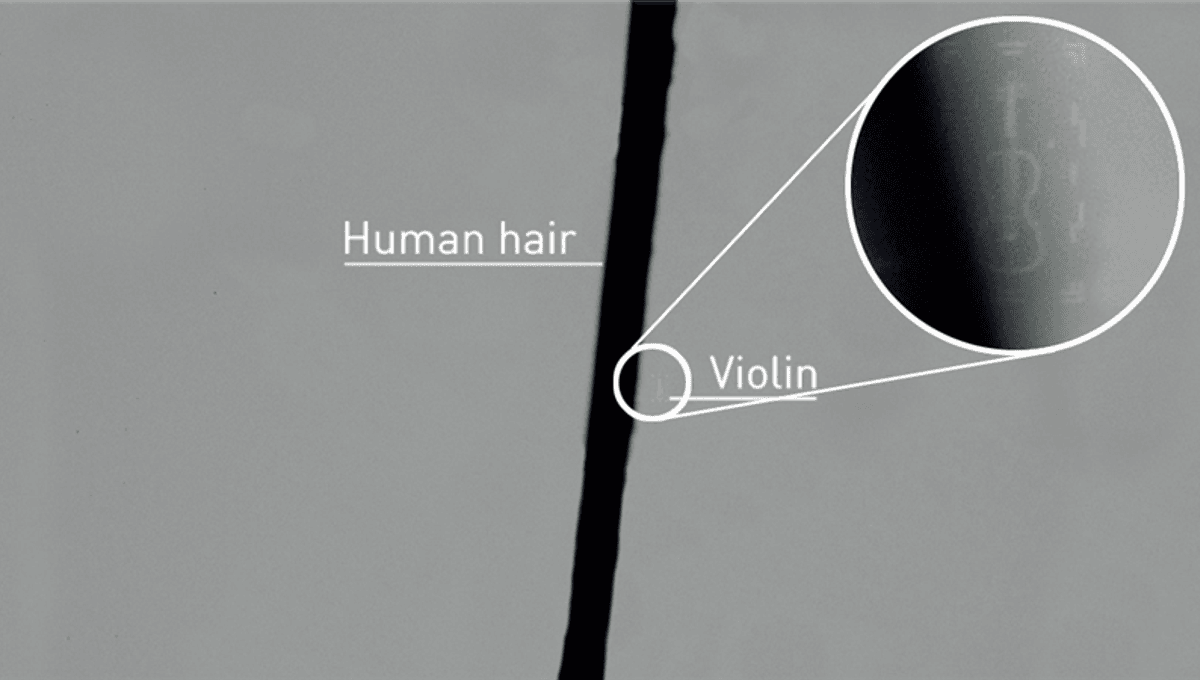
Physicists have created a “nano-violin” so small that it could fit within the width of a human hair. This is not only good news for anyone feeling sorry for themselves – it also demonstrates the capabilities of a new nanolithography system that allows researchers to build and study nanoscale structures. It will help researchers identify new materials and methods to enhance future generations of computers.
The tiny violin is made of platinum and is just 35 microns (35 millionths of a meter) long and 13 wide. To put that into perspective, a human hair is typically around 17 to 180 microns in diameter, while the famous tardigrades – the adorable and tough microorganisms – are between 50 and 1,200 microns.
But before you think this will become the first step towards nano-bands or a prelude to the smallest concert in history, it’s important to point out that the instrument is not actually playable. Not even if you could shrink yourself to its size. This is because the violin is just a microscopic image of a violin.
“Though creating the world’s smallest violin may seem like fun and games, a lot of what we’ve learned in the process has actually laid the groundwork for the research we’re now undertaking,” Professor Kelly Morrison, Head of the Physics department at Loughborough University, explained in a statement.
“Our nanolithography system allows us to design experiments that probe materials in different ways – using light, magnetism, or electricity – and observe their responses. Once we understand how materials behave, we can start applying that knowledge to develop new technologies, whether it’s improving computing efficiency or finding new ways to harvest energy. But first, we need to understand the fundamental science and this system enables us to do just that.”
So how did they create this micro-violin? Morrison and colleagues Dr Naëmi Leo and research technician Dr Arthur Coveney started by coating a small chip with two layers of resist, a gel-like material. The chip was then put under the NanoFrazor – a nanofabrication tool that has an ultra-sharp heated probe at its tip – which effectively “wrote” the violin image onto the chip’s surface.
Following this, the resist was dissolved from the chip to expose the underlayer, leaving a violin-shaped cavity. Then a thin layer of platinum was put onto the chip before a final wash in acetone removed the last bits of material. What was left was the finished violin.
All these processes took place in the carefully controlled environment of an enclosed glovebox connected to a suite of interconnected chambers. This was to prevent dust and moisture from impacting the research. To achieve this, the chip was moved between chambers using metal arms that the researchers manipulated from outside.
Now that the system is in operation, the team believe they could create a violin in about three hours, but the final product took several months as they attempted to refine their techniques.
There are two research projects currently using the new nanolithography system (not creating any more tiny instruments). One is investigating alternatives to magnetic data storage, while the other looks at how heat can be used to faster and more energy-efficient data storage/processing.
“I’m really excited about the level of control and possibilities we have with the set-up,” said Morrison added, “I’m looking forward to seeing what I can achieve – but also what everyone else can do with the system.”
Morrison has created a blog that goes into greater detail about the violin’s creation.
Source Link: "World's Smallest" Nano-Violin Measures Less Than A Hair's Width – But Could Lead To Big Discoveries